Perched at the southernmost tip of India, where the Arabian Sea, the Bay of Bengal, and the Indian Ocean come together in a breathtaking confluence, the Kanyakumari Bhagavathy Amman Temple stands as a symbol of divine energy and unwavering faith.
The rhythmic sound of waves, the coastal breeze infused with incense, and the steady flow of pilgrims create an atmosphere that is both serene and spiritually charged.
This ancient temple is more than a scenic marvel—it is one of the revered 108 Shakti Peethas, places believed to be charged with the feminine power of Goddess Shakti.
Devotees travel from across India to seek blessings from Devi Kanya Kumari, the youthful goddess who, according to mythology, embodies eternal virginity and powerful compassion.
As a sacred site steeped in centuries of devotion, the temple holds a special place in the hearts of millions who find peace, strength, and purpose in its presence.
Historical Significance of Kanyakumari Bhagavathy Amman Temple
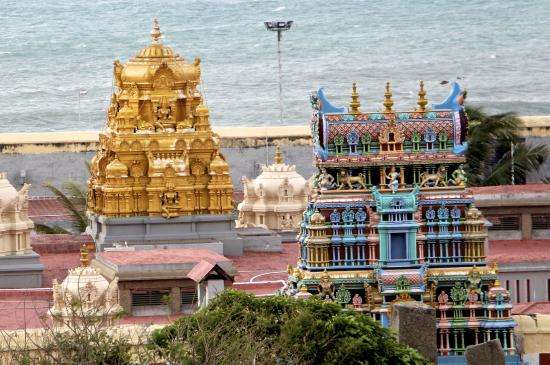
The Kanyakumari Bhagavathy Amman Temple is not just a site of daily worship—it is a living chapter from India’s ancient past. With a history that stretches back more than 3,000 years, the temple is deeply rooted in time and tradition.
It finds mention in revered epics such as the Ramayana, Mahabharata, and various Puranas, which highlight its prominence as a divine and strategic spiritual landmark.
The temple’s mythological foundation is just as compelling. According to legend, Goddess Kanya Kumari—a powerful incarnation of Goddess Parvati—chose this coastal site to perform intense penance as she awaited union with Lord Shiva.
When the wedding was mystically interrupted, the goddess remained in her youthful, unmarried form, blessing the land and its people with her presence. This tale of devotion, patience, and divine purpose gives the temple its enduring identity as a symbol of purity and feminine power.
For generations, pilgrims have journeyed here not just to pray, but to connect with a story that blends myth and history—where stone walls echo with the strength of a goddess who chose solitude and sacrifice over fulfillment, all for the sake of cosmic balance.
Read Also: Exploring the Legacy of Mansa Devi Temple, Uttarakhand
Architectural Marvels of Kanyakumari Bhagavathy Amman Temple
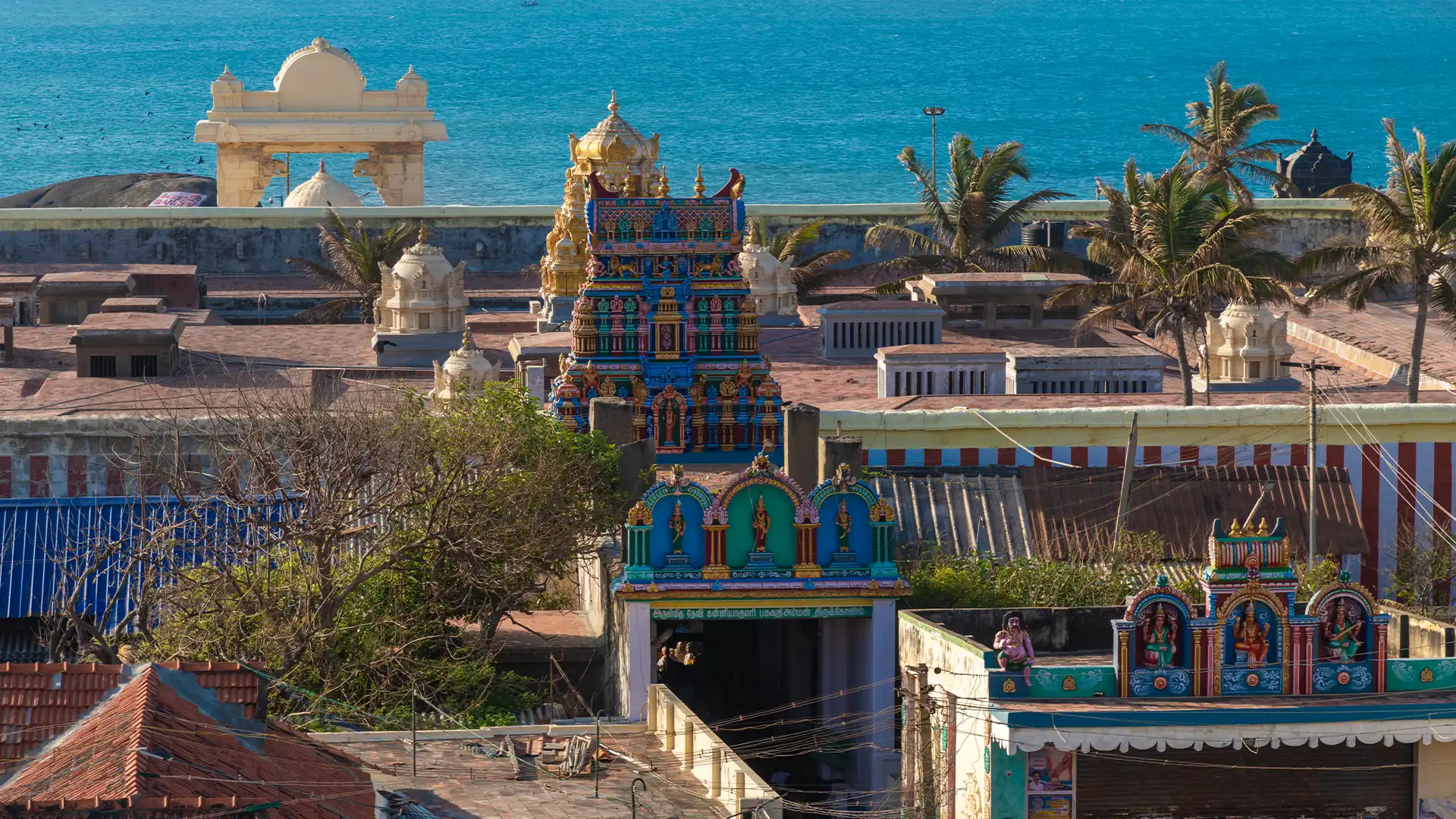
The Kanyakumari Bhagavathy Amman Temple is a striking example of classic Dravidian architecture, blending artistry with spirituality.
The temple’s towering gopuram (gateway tower), adorned with detailed carvings and vibrant sculptures, serves as both a visual landmark and a spiritual threshold.
As visitors step through its ancient doorway, they are welcomed into a space where intricate stonework and symmetrical mandapams (pillared halls) reflect centuries of craftsmanship and devotion.
At the heart of the temple lies the sanctum sanctorum, a sacred chamber that houses the idol of Devi Kanya Kumari.
The deity is depicted in a serene, youthful form, adorned with sparkling nose rings said to shine so brightly they were once mistaken for lighthouse beams by passing ships. This legend adds both mystery and allure to the temple’s unique coastal setting.
What sets this temple apart architecturally is not just its design but its location—nestled right at the edge of the Indian mainland, it offers panoramic views of the meeting point of three oceans.
At sunrise and sunset, the temple glows with a golden hue, creating a breathtaking harmony between earth, ocean, and sky. It’s a place where devotion meets design, and where ancient stone tells stories of gods, legends, and the timeless pull of faith.
Read Also: Kalighat Kali Temple Guide: History, Rituals & Travel
Religious Significance and Rituals at Kanyakumari Bhagavathi Amman Temple
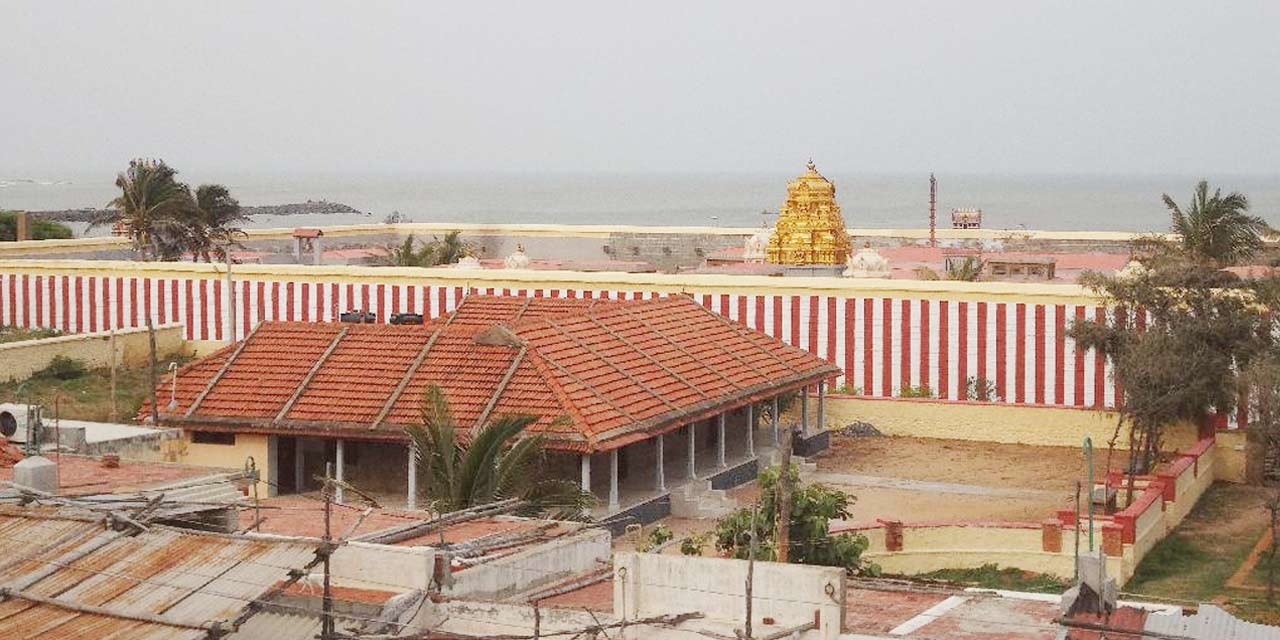
The Kanyakumari Bhagavathy Amman Temple is not only a marvel of mythology and architecture but also a deeply spiritual center where centuries-old rituals continue to shape the daily rhythm of life.
Each day begins with the Deeparadhana, a ceremonial lighting of lamps that fills the temple with a warm, golden glow, symbolizing the presence of the divine.
Devotees gather in reverence as priests conduct Abhishekam (ritual bathing of the deity), chant Vedic hymns, and perform Alankaram, adorning the goddess in vibrant silks and fresh flowers.
Throughout the day, various poojas and aarti ceremonies are performed at regular intervals, allowing pilgrims from all walks of life to participate in the goddess’s worship.
Fridays and new moon days hold special importance, often drawing larger crowds who come to offer kumkum, coconuts, and oil lamps—symbols of their hopes and prayers.
For many, this temple is a lifelong spiritual milestone, not just a tourist stop. Pilgrims believe that the blessings of Devi Kanya Kumari bring peace, prosperity, and inner strength.
It’s not uncommon to see families making their way barefoot to the temple, hands folded, eyes closed, seeking solace from life’s burdens or expressing gratitude for answered prayers.
With its daily rhythm of rituals and deep spiritual ambiance, the temple continues to be a sanctuary of faith, where devotion is both personal and collective—linking past to present, and individual hearts to the divine feminine.
Read Also: Explore Kamakhya Temple, Assam’s Spiritual Jewel
Festivals Celebrated at Kanyakumari Bhagavathy Amman Temple
Festivals at the Kanyakumari Bhagavathy Amman Temple are vibrant spiritual experiences, where tradition, music, and devotion come together in spectacular celebration. Among the many festivals, Navaratri stands out as the most significant.
This grand 10-day celebration, typically held in September or October, honors the divine feminine in all her forms. The temple becomes a hub of activity, adorned with colorful decorations and illuminated with oil lamps.
Special rituals and poojas are conducted each day, while devotional music and cultural performances draw thousands of devotees from across the country.
Another key celebration is the Chithirai Festival, held during the Tamil month of Chithirai (April–May).
This festival commemorates the goddess’s eternal spiritual presence and includes processions, traditional drumming, and lively folk performances that fill the temple grounds with festive energy.
Locals and pilgrims alike line the streets to witness the procession of the deity, carried with reverence on a decorated chariot.
These festivals not only honor the mythological and religious significance of Devi Kanya Kumari but also reinforce the temple’s role as a cultural and spiritual anchor in the region.
Whether you’re a lifelong devotee or a first-time visitor, the energy during these festivals is truly unforgettable—offering a deep sense of connection, community, and divine celebration.
Read Also: Dakshineswar Kali Temple, West Bengal: Explore Spiritual Grace
Visitor Information for Kanyakumari Bhagavathy Amman Temple
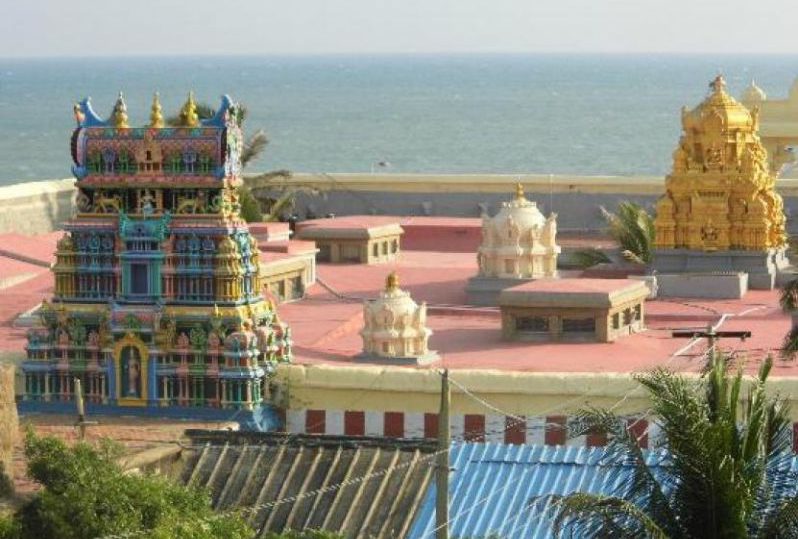
Planning a visit to the Kanyakumari Bhagavathy Amman Temple requires just a few simple guidelines to ensure a smooth and respectful experience.
The temple is typically open to devotees from 4:30 AM to 12:30 PM, and again in the evening from 4:00 PM to 8:00 PM. Early mornings are especially peaceful, offering a chance to witness serene rituals like the Suprabhatham, which marks the ceremonial waking of the goddess.
When it comes to dress code and etiquette, visitors are encouraged to wear traditional Indian attire—sarees or salwar kameez for women, and dhotis or trousers for men.
This reflects cultural reverence and aligns with the temple’s spiritual atmosphere. Footwear must be removed before entering the premises, and maintaining silence or speaking in low tones is appreciated. Photography is usually restricted within the sanctum, so it’s best to ask the temple staff beforehand.
As for entry, the temple is open to all without any entrance fee. However, if you wish to participate in special poojas, darshan passes or offerings may carry a nominal charge, often used for temple upkeep and services.
Whether you’re there for a quiet prayer or a grand ritual, a visit to this sacred site offers a meaningful blend of tradition, tranquility, and devotion.
Read Also: Jhandewalan Temple, New Delhi: Timings, Rituals & Everything
Exploring the Surroundings of Kanyakumari Bhagavathy Amman Temple
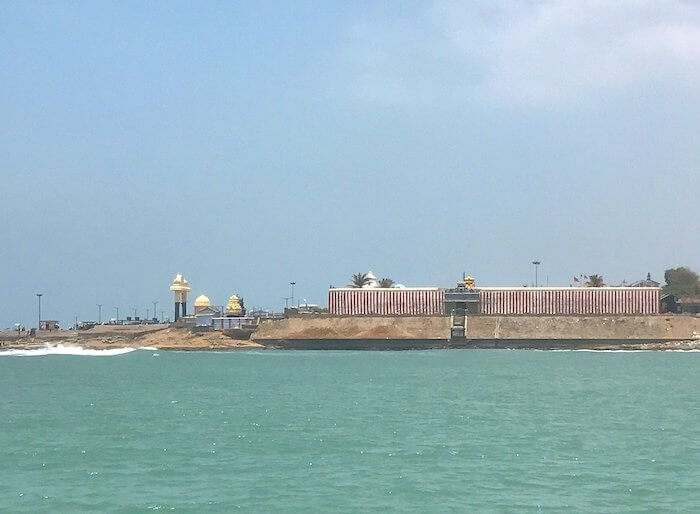
A visit to the Kanyakumari Bhagavathy Amman Temple offers more than spiritual solace—it’s also a gateway to exploring some of South India’s most iconic coastal attractions.
Just a short ferry ride away lies the Vivekananda Rock Memorial, a revered monument built in honor of Swami Vivekananda’s enlightenment at this very spot.
Standing tall beside it is the Thiruvalluvar Statue, a majestic 133-foot stone tribute to the ancient Tamil poet and philosopher, symbolizing wisdom and moral integrity.
Just steps from the temple, you’ll find the Triveni Sangam, the confluence of the Arabian Sea, Bay of Bengal, and Indian Ocean—a rare geographical wonder.
Watching the sunrise or sunset here, with the sky painted in hues of orange and pink, is a mesmerizing experience for both pilgrims and travelers.
When it’s time to eat, the streets around the temple are filled with the aroma of authentic South Indian cuisine. Don’t miss local favorites like steaming idlis, crispy dosas, spicy sambar, and freshly brewed filter coffee.
Small family-run eateries and local dhabas serve these with warm hospitality, often on banana leaves for a truly traditional touch.
Together, the spiritual charm of the temple and the cultural richness of its surroundings make Kanyakumari a destination that nourishes both soul and senses.
Read Also: Shri Mata Vaishno Devi Mandir: Travel, Weather, and Yatra Tips
Travel Tips for Visiting Kanyakumari Bhagavathy Amman Temple

Planning your trip to the Kanyakumari Bhagavathy Amman Temple is key to making the most of this spiritually and scenically rich destination.
The best time to visit is between October and March, when the coastal weather is at its most pleasant—ideal for temple visits, sightseeing, and watching the famous Kanyakumari sunrise and sunset without the discomfort of humidity or heat.
When it comes to accommodation, Kanyakumari caters to all kinds of travelers. From budget-friendly guesthouses starting around ₹800 per night, to mid-range hotels with sea views and modern amenities in the ₹2,000–₹3,500 range, you’ll find plenty of options.
Some accommodations even offer early check-in and spiritual tour packages tailored for pilgrims.
Getting to Kanyakumari is convenient too. The town is well-connected by road, rail, and air. The nearest airport is Trivandrum International Airport, located about 90 km away, with regular taxis and buses to Kanyakumari.
The Kanyakumari railway station is centrally located and links to major cities like Chennai, Bengaluru, and Mumbai. For road travelers, smooth highways and frequent buses make it an easy journey from across Tamil Nadu and neighboring states.
With the right planning, your visit to this sacred site can be both comfortable and spiritually enriching.
Trip expense to Kanyakumari’s Bhagavathy Amman Temple

The trip expense to Kanyakumari’s Bhagavathy Amman Temple can vary depending on your travel style (budget, mid-range, or luxury) and where you’re traveling from. Here’s a general breakdown of costs for a 2-day trip from a major city in India (like Chennai, Bangalore, or Kochi.
Estimated Budget for a 2-Day Trip to Kanyakumari’s Bhagavathy Amman Temple
| Expense Category | Budget (₹) | Mid-Range (₹) | Luxury (₹) |
| Travel (round trip) | 1,000–1,500 (train/bus) | 2,000–4,000 (AC train or cab) | 6,000–12,000 (flight + cab) |
| Stay (1 night) | 600–1,000 (budget lodge) | 1,500–3,000 (3-star hotel) | 4,000–8,000 (resort/hotel) |
| Food | 300–500/day | 700–1,000/day | 1,500–2,500/day |
| Local transport | 200–500 (auto/shared) | 600–1,000 (cab rental) | 1,500–2,000 |
| Temple & local visits | Free–200 (entry/offerings) | 200–500 | 500–1,000 (guided tour) |
| Misc. shopping, tips | 300–500 | 500–1,000 | 1,000–2,000 |
Total Approximate Trip Cost (per person)
- Budget traveler: ₹2,400 – ₹4,000
- Mid-range traveler: ₹5,000 – ₹9,500
- Luxury traveler: ₹14,000 – ₹25,000+
Bonus Tips:
- The temple has no entry fee.
- The best time to visit is October to March (pleasant weather).
- Combine it with a visit to Vivekananda Rock Memorial and Sunset Point to get the full experience.
Conclusion
The Kanyakumari Bhagavathy Amman Temple is far more than just a pilgrimage site—it’s a living embodiment of India’s rich spiritual legacy, mythological depth, and architectural brilliance.
From its sacred status as one of the 108 Shakti Peethas to its coastal setting where three oceans meet, the temple offers a profound sense of peace and purpose to all who visit.
The legend of Goddess Kanya Kumari, its centuries-old rituals, and the grandeur of Dravidian design all weave together to create a sacred space where the divine feels tangibly close.
Whether you’re a devout pilgrim or a curious traveler, a visit here promises more than just prayer—it delivers an experience that is spiritually uplifting, historically fascinating, and scenically stunning.
The Kanyakumari Bhagavathy Amman Temple invites you to pause, reflect, and reconnect with something timeless.

